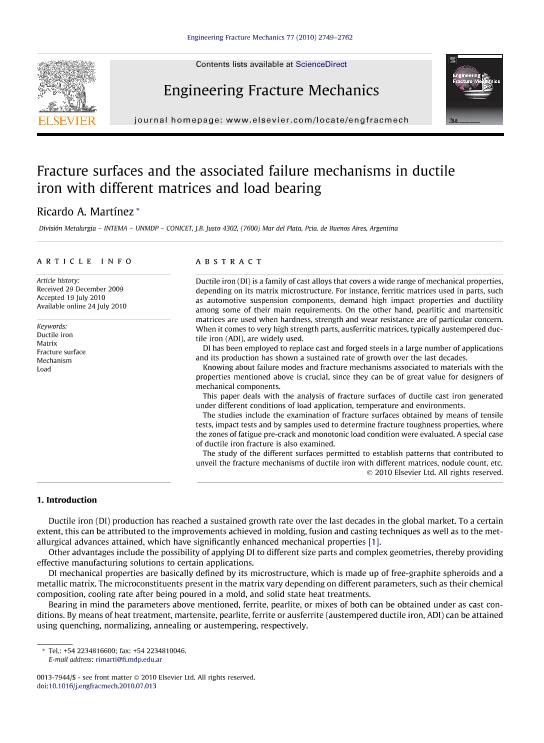Mostrar el registro sencillo del ítem
dc.contributor.author
Martinez, Ricardo Antonio

dc.date.available
2017-02-17T17:52:33Z
dc.date.issued
2010-07-24
dc.identifier.citation
Martinez, Ricardo Antonio; Fracture surfaces and the associated failure mechanisms in ductile iron with different matrices and load bearing; Elsevier; Engineering Fracture Mechanics; 77; 14; 24-7-2010; 2749-2762
dc.identifier.issn
0013-7944
dc.identifier.uri
http://hdl.handle.net/11336/13137
dc.description.abstract
Ductile iron (DI) is a family of cast alloys that covers a wide range of mechanical properties, depending on its matrix microstructure. For instance, ferritic matrices used in parts, such as automotive suspension components, demand high impact properties and ductility among some of their main requirements. On the other hand, pearlitic and martensitic matrices are used when hardness, strength and wear resistance are of particular concern. When it comes to very high strength parts, ausferritic matrices, typically austempered ductile iron (ADI), are widely used. DI has been employed to replace cast and forged steels in a large number of applications and its production has shown a sustained rate of growth over the last decades. Knowing about failure modes and fracture mechanisms associated to materials with the properties mentioned above is crucial, since they can be of great value for designers of mechanical components. This paper deals with the analysis of fracture surfaces of ductile cast iron generated under different conditions of load application, temperature and environments. The studies include the examination of fracture surfaces obtained by means of tensile tests, impact tests and by samples used to determine fracture toughness properties, where the zones of fatigue pre-crack and monotonic load condition were evaluated. A special case of ductile iron fracture is also examined. The study of the different surfaces permitted to establish patterns that contributed to unveil the fracture mechanisms of ductile iron with different matrices, nodule count, etc.
dc.format
application/pdf
dc.language.iso
eng
dc.publisher
Elsevier

dc.rights
info:eu-repo/semantics/openAccess
dc.rights.uri
https://creativecommons.org/licenses/by-nc-nd/2.5/ar/
dc.subject
Fundición
dc.subject
Superficie de Fractura
dc.subject
Matriz
dc.subject
Mecanismo
dc.subject
Ductile Iron
dc.subject
Matrix
dc.subject
Fracture Surface
dc.subject
Mechanism
dc.subject
Load
dc.subject.classification
Otras Ingeniería Mecánica

dc.subject.classification
Ingeniería Mecánica

dc.subject.classification
INGENIERÍAS Y TECNOLOGÍAS

dc.subject.classification
Ingeniería de los Materiales

dc.subject.classification
Ingeniería de los Materiales

dc.subject.classification
INGENIERÍAS Y TECNOLOGÍAS

dc.title
Fracture surfaces and the associated failure mechanisms in ductile iron with different matrices and load bearing
dc.type
info:eu-repo/semantics/article
dc.type
info:ar-repo/semantics/artículo
dc.type
info:eu-repo/semantics/publishedVersion
dc.date.updated
2017-02-06T14:31:21Z
dc.journal.volume
77
dc.journal.number
14
dc.journal.pagination
2749-2762
dc.journal.pais
Estados Unidos

dc.journal.ciudad
Atlanta
dc.description.fil
Fil: Martinez, Ricardo Antonio. Consejo Nacional de Investigaciones Científicas y Técnicas. Centro Científico Tecnológico Mar del Plata. Instituto de Investigación en Ciencia y Tecnología de Materiales (i); Argentina. Universidad Nacional de Mar del Plata. Facultad de Ingeniería; Argentina
dc.journal.title
Engineering Fracture Mechanics

dc.relation.alternativeid
info:eu-repo/semantics/altIdentifier/doi/http://dx.doi.org/10.1016/j.engfracmech.2010.07.013
dc.relation.alternativeid
info:eu-repo/semantics/altIdentifier/url/http://www.sciencedirect.com/science/article/pii/S0013794410003486
Archivos asociados
